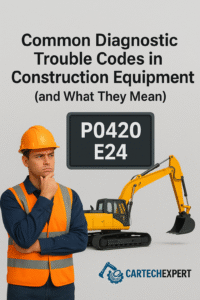Physical Address
Arthur Avenue , BrookField , ILLINOIS , 60513 , United State

Construction machines today are full of electronics. Excavators, loaders, graders, and dozers all use sensors and control modules to keep the engine, hydraulics, and emissions systems running properly. When something goes wrong, the machine records a diagnostic trouble code (DTC). These codes can look confusing at first, but once you know how they are structured, they become a valuable guide. This article explains the most common codes, what they mean, and how to respond to them.
A DTC is a short message from the machine’s computer. It doesn’t always point to a broken part. Often, it highlights a parameter that is out of range or a signal that doesn’t look right. Heavy equipment uses the SAE J1939 standard, which relies on three parts:
A full code often looks like this: SPN 3226 FMI 13 MID 128. Each part adds meaning. Together, they tell the story of what the machine noticed.
Codes reduce guesswork. Instead of searching randomly, you can go straight to the area where the fault was detected. Ignoring them can lead to more serious problems. For example, a diesel particulate filter (DPF) restriction code may seem minor at first but can cause engine derate or failure if not handled quickly. Paying attention to codes helps prevent downtime and protects expensive components.
Always read all three. Searching for just the SPN online can mislead you. The same SPN can mean different things depending on the FMI and the MID.
The most frequent codes today relate to aftertreatment systems. Modern diesel engines use a diesel particulate filter (DPF) and selective catalytic reduction (SCR) with DEF (Diesel Exhaust Fluid). These systems reduce soot and NOx emissions but are sensitive to poor DEF quality, clogged filters, and sensor faults.
Sensors such as coolant temperature, oil pressure, fuel rail pressure, and boost pressure keep the engine safe. If their signals are wrong, the machine may derate or shut down.
Common causes: sensor damage, harness wear, low voltage, or contamination.
Quick checks: confirm battery voltage, inspect wiring, and compare readings with a manual gauge.
Construction machines use a CAN bus network to link all modules. If communication fails, you may see multiple unrelated codes at once.
Common causes: faulty module, damaged CAN wiring, poor ground connections, or voltage spikes.
Quick checks: inspect wiring harnesses, test continuity, and confirm stable voltage supply.
Modern transmissions have their own control units. Codes here often point to solenoids, pressure sensors, or fluid problems.
Common causes: low or incorrect oil, faulty solenoids, worn internal parts.
Quick checks: verify oil level and condition, check for leaks, and follow OEM transmission code flowcharts.
Hydraulic systems can also trigger codes, especially when pressure or flow sensors detect abnormal readings.
Common causes: pressure sensor faults, valve failures, or fluid contamination.
Quick checks: inspect hoses and fittings, test pressure at service ports, and check filter condition.
Overheating is serious. Codes here protect the engine from major damage.
Common causes: low coolant, faulty thermostat, failed fan drive, or temperature sensor error.
Quick checks: confirm coolant level, inspect the radiator and fan system, and monitor live temperature readings.
Case 1 — SPN 3226 FMI 13 (NOx sensor).
An excavator logged this code. After checking DEF quality and inspecting the harness, the technician found corrosion in the sensor connector. Cleaning and resealing fixed the issue without replacing the sensor.
Case 2 — SPN 3251 FMI 0 (DPF pressure).
A loader showed high DPF pressure. A forced regeneration failed. Inspection revealed a cracked pressure line. Replacing the line solved the problem, saving the customer from a costly DPF replacement.
Some codes appear only under certain conditions. These are often wiring or connection issues. Record the circumstances, try to reproduce the problem, and focus on connectors or heat-affected areas. Avoid replacing parts until you can confirm the fault.
Do basic checks yourself if you can. Replace simple sensors, connectors, or fuses. But call the dealer if:
Each time a code appears, write down:
Diagnostic codes are not the enemy. They are clues. With a methodical approach, you can find the root cause without wasting time or money. Start with the basics, trust the OEM manual, and keep good records. In most cases, the solution is as simple as a connector, a sensor, or a blocked filter.
If you work on construction machines, make a habit of logging every fault you see. Over time, your own records will become the most valuable troubleshooting guide you have.
